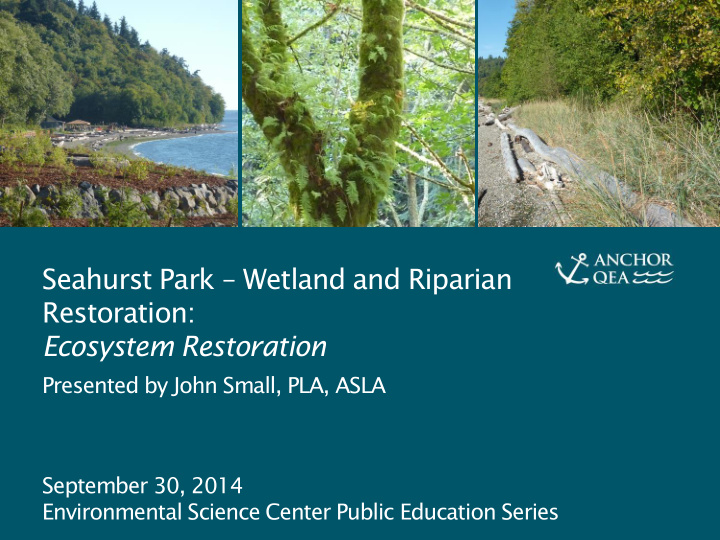



Seahurst Park – Wetland and Riparian Restoration: Ecosystem Restoration Presented by John Small, PLA, ASLA September 30, 2014 Environmental Science Center Public Education Series Seahurst Park – Wetland and Riparian Restoration: 0 Ecosystem Restoration
Presentation Overview 1. Introduction to Landscapes and Ecosystems 2. Plant Communities of Seahurst Park 3. Restoration Design and Construction 4. Maintenance and Sustainability Seahurst Park – Wetland and Riparian Restoration: 1 Ecosystem Restoration
1. Introduction to Landscapes and Ecosystems o Landscapes o Ecosystems o Communities o Habitats Seahurst Park – Wetland and Riparian Restoration: 2 Ecosystem Restoration
Ecosystem Restoration Goals Before • Preserve existing high-functioning nearshore habitats • Restore and protect the natural bluff- to-beach sediment process • Restore beach slopes and substrates • Restore forage-fish spawning, juvenile salmon rearing, and migration After intertidal habitats • Restore upland and shallow intertidal habitat connectivity • Diversify habitat in the freshwater/saltwater interface Seahurst Park – Wetland and Riparian Restoration: 3 Ecosystem Restoration
Detritus-based Food Web The entire food web is based • largely on nutrients from land Vegetation broken down by • bacteria, fungi, zoo plankton and insects Occurs on land and in • nearshore, out to the edges of the photic zone Seahurst Park – Wetland and Riparian Restoration: 4 Ecosystem Restoration
Process-based Restoration Approach Conceptual Model: The role of Puget Sound nearshore beaches in sustaining Wave energy Process forage fish Sediment delivery Sediment transport Beach profile Forage fish spawning Structure Function Sediment grain size and production Beach temperature Food web support Source, Conceptual Model: PSNERP and Simenstad et al. 2006; Penttila 2007 Seahurst Park – Wetland and Riparian Restoration: 5 Ecosystem Restoration
Supporting Habitat-forming Processes Source: King County WRIA 9 Seahurst Park – Wetland and Riparian Restoration: 6 Ecosystem Restoration
Bluff-to-beach Sediment Supply Processes Accretion zone Accretion zone Net Shore Drift Seahurst Park – Wetland and Riparian Restoration: 7 Ecosystem Restoration
Habitat Preservation and Restoration Zones Seahurst Park – Wetland and Riparian Restoration: 8 Ecosystem Restoration
Reconnecting Terrestrial/Riparian and Aquatic/Intertidal Habitats Seahurst Park – Wetland and Riparian Restoration: 9 Ecosystem Restoration
Reconnecting Freshwater Streams and Marine Habitats Seahurst Park – Wetland and Riparian Restoration: 10 Ecosystem Restoration
Balancing Habitat, Access, and Shoreline Stability Seahurst Park – Wetland and Riparian Restoration: 11 Ecosystem Restoration
Terrestrial Communities Madrone/Salal Madrone • Salal • Big Leaf Maple • Indian Plum • Sword Fern • Sandy, Drier Soils Seahurst Park – Wetland and Riparian Restoration: 12 Ecosystem Restoration
Terrestrial Communities Hemlock/Douglas fir Vine Maple • Salal • Salmonberry • Indian Plum • Sword Fern • Less Disturbed, Second-growth, Drier Soils Seahurst Park – Wetland and Riparian Restoration: 13 Ecosystem Restoration
Terrestrial Communities Western Red Cedar Salmonberry • Lady Fern • Skunk Cabbage • Devil’s Club • Less Disturbed, Second-growth, Wetter Soils Seahurst Park – Wetland and Riparian Restoration: 14 Ecosystem Restoration
Terrestrial Communities Alder/Salmonberry Horsetails • Salal • Piggyback Plant • Lady Fern • Blackberry • Disturbed Areas, Wetter Soils Seahurst Park – Wetland and Riparian Restoration: 15 Ecosystem Restoration
On-site Unstable Hillsides Map Source: Shannon & Wilson 2002 Seahurst Park – Wetland and Riparian Restoration: 16 Ecosystem Restoration
Aquatic Communities Source: King County WRIA 9 Seahurst Park – Wetland and Riparian Restoration: 17 Ecosystem Restoration
Accretion Zones are Hot-spots in a Detritus- based Food Web Accretion zone Accretion zone Net Shore Drift Seahurst Park – Wetland and Riparian Restoration: 18 Ecosystem Restoration
South Shoreline After Re-vegetation Seahurst Park – Wetland and Riparian Restoration: 19 Ecosystem Restoration
Beach Communities Dune Grass ( Elymus mollis ) Gumweed • Vetch • Coastal Strawberry • Salt Grass ( Distichilis spicata ) • Pickleweed Fat Hen • Jaumea • Silverweed ( Potentilla Pac. ) • Seahurst Park – Wetland and Riparian Restoration: 20 Ecosystem Restoration
Marsh Communities Dune Grass ( Elymus mollis ) Gumweed • Vetch • Coastal Strawberry • Salt Grass ( Distichilis spicata ) • Pickleweed Fat Hen • Jaumea • Silverweed ( Potentilla Pac. ) • Carex • Seahurst Park – Wetland and Riparian Restoration: 21 Ecosystem Restoration
Submerged Aquatic Vegetation Eelgrass • Kelp • Algae • Seahurst Park – Wetland and Riparian Restoration: 22 Ecosystem Restoration
North Shoreline – Completed Beach Seahurst Park – Wetland and Riparian Restoration: 23 Ecosystem Restoration
Is It Working? Source: Armbrust, Toft, and Cordell 2009 Seahurst Park – Wetland and Riparian Restoration: 24 Ecosystem Restoration
Is It Working? Source: Armbrust, Toft, and Cordell 2009 Seahurst Park – Wetland and Riparian Restoration: 25 Ecosystem Restoration
Is It Working? What juvenile chinook eat at Seahurst Park: Source: Brennan, Higgins, Cordell, and Stamatiou 2004 Seahurst Park – Wetland and Riparian Restoration: 26 Ecosystem Restoration
Summary 1. Introduction to Landscapes and Ecosystems 2. Plant Communities of Seahurst Park 3. Restoration Design and Construction 4. Maintenance and Sustainability Seahurst Park – Wetland and Riparian Restoration: 27 Ecosystem Restoration
North Shoreline – Completed Beach Seahurst Park – Wetland and Riparian Restoration: 28 Ecosystem Restoration
North Shoreline – Pre-project Seahurst Park – Wetland and Riparian Restoration: 29 Ecosystem Restoration
North Shoreline – Path and Beach Construction Seahurst Park – Wetland and Riparian Restoration: 30 Ecosystem Restoration
Recommend
More recommend